
tnfd.global
Discussion paper on
Draft sector metrics
December 2023
For market consultation and feedback
SASB sectors:
Apparel and textiles (CG.1)
Construction materials (EM.2)
Infrastructure (IF.2)
Real estate (IF.3)

Draft sector metrics
For market consultation and feedback – December 2023
1
Contents
Introduction 2
Open for consultation 4
Consumer goods 6
Apparel & textiles 6
Proposed guidance on the application of the core
global disclosure metrics 6
Proposed core sector disclosure indicators and metrics 14
Proposed additional sector disclosure indicators and metrics 15
Extractives & minerals processing 16
Construction materials 16
Proposed guidance on the application of the core
global disclosure metrics 16
Proposed core sector disclosure indicators and metrics 24
Proposed additional sector disclosure indicators and metrics 25
Infrastructure 26
Infrastructure; Real estate 26
Proposed guidance on the application of the core
global disclosure metrics 26
Proposed core sector disclosure indicators and metrics 36
Proposed additional sector disclosure indicators and metrics 37
Glossary 39
References 44
This work is licensed under a
Creative Commons Attribution
4.0 International License.

Draft sector metrics
For market consultation and feedback – December 2023
2
Introduction
1 Including the GBF, ISSB IFRS-S1 and S2 standards; TCFD; Carbon Disclosure Standards Board (CDSB) and Sustainability Accounting
Standards Board (SASB); GRI, CDP and the European Financial Reporting Advisory Group (EFRAG); and corporate target setting methods
developed by the Science Based Targets Network (SBTN).
2 Taskforce on Nature-related Financial Disclosures (2022) A landscape assessment of nature-related data and analytics availability.
The TNFD Recommendations provide companies and
nancial institutions of all sizes with a risk management
and disclosure framework to identify, assess, manage
and, where appropriate, disclose nature-related issues.
This includes a set of recommended metrics to support
organisations’ assessment and disclosure of nature-
related dependencies, impacts, risks and opportunities.
The Taskforce’s approach to metrics is anchored in the
principles that metrics should be:
• Science-based and provide insights into the
consequences of business and nance activities;
• Be sensitive enough to reect change on an annual
basis;
• Relevant to the business model and value chain
of report preparers, recognising that issues within
sectors, business models and value chains can vary
signicantly;
• Proportionate, reecting the practical capacity and
cost constraints of report preparers to assemble,
assess and report information on an annual reporting
cycle;
• Decision-useful to the primary users of corporate
sustainability reports, oering current insights and
comparability within and across sectors;
• Subjectable to independent limited assurance in
the medium term; and
• Aligned to global and national policy goals
and targets, such as the indicators and metrics
in the Kunming-Montreal Global Biodiversity
Framework (GBF) and other international treaties
– as organisations are now aligning to the Paris
Agreement and net zero targets with respect to their
climate-related corporate disclosures – as well as
other standards and target setting frameworks.
1
The TNFD recognises that the scope, consistency
and accessibility of some nature-related data currently
available to some market participants means that
it is challenging to achieve all these principles
simultaneously.
2
To reconcile the large number of
indicators associated with nature-related issues, and the
needs of market participants for a small set of indicators
that can be compared and subjected to third-party
assurance on an annual basis as a key requirement for
disclosure, the TNFD has adopted a leading indicators
approach to measurement.
The TNFD’s metrics approach includes dierent
categories of metrics (Figure 1). These include:
• A small set of core metrics – ‘core global metrics’ that
apply to all sectors and ‘core sector metrics’ for each
sector – to be disclosed on a comply or explain basis;
and
• A larger set of additional metrics, which are
recommended for disclosure, where relevant, to best
represent an organisation’s material nature-related
issues, based on their specic circumstances.
Sector-specic metrics form an important part of this
approach. This reects the diversity of business models
across value chains and their interface with nature
across and within sectors. Sector-specic metrics
help nancial institutions to compare organisations
within the same sector, which often face similar nature-
relatedissues.
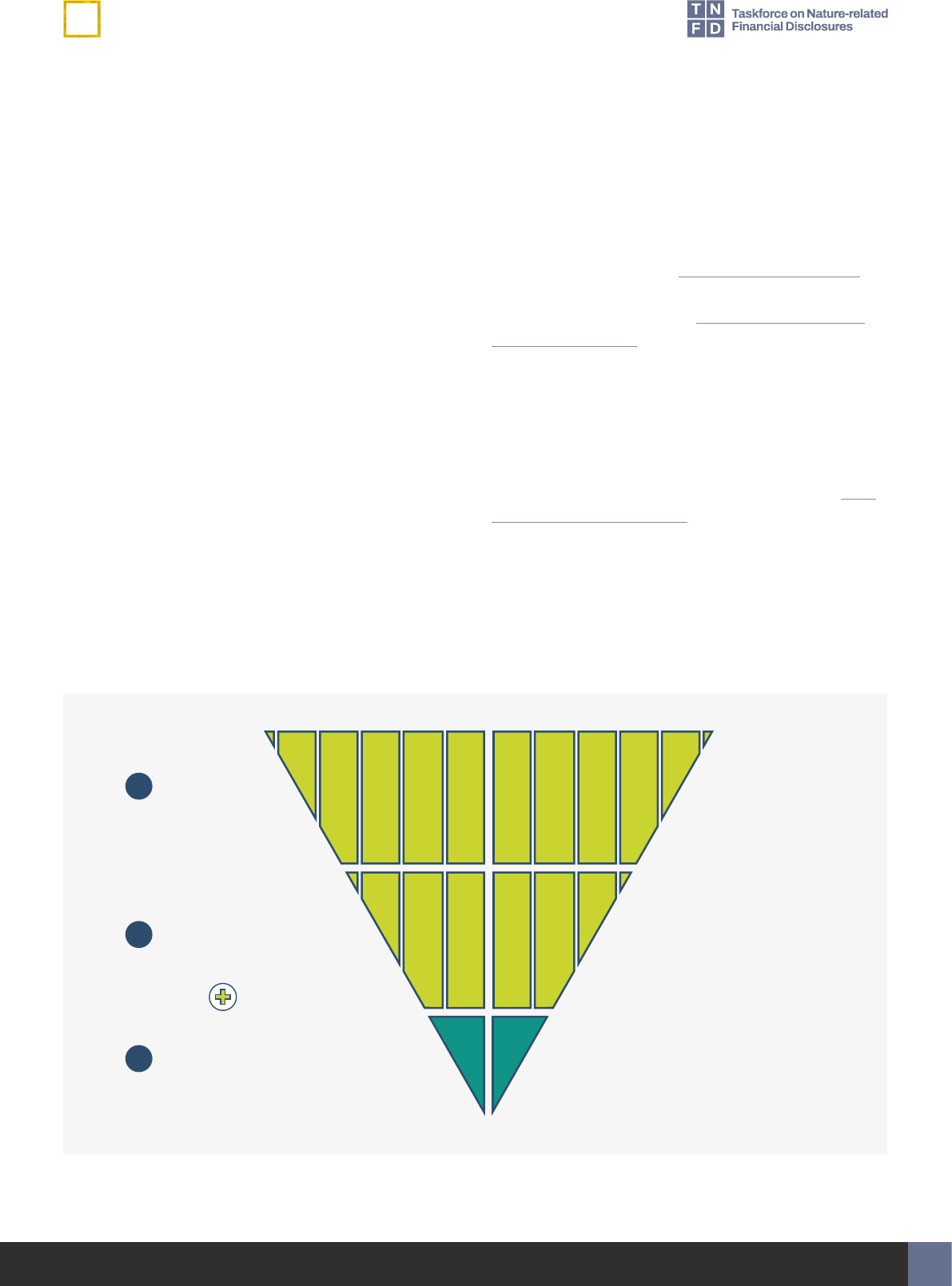
3
Draft sector metrics
For market consultation and feedback – December 2023
For the sectors shown in Figure 2, this discussion
paperpresents:
• Proposed guidance on how to apply the TNFD core
global disclosure metrics in each sector, where
relevant;
• Proposed core sector disclosure metrics:
Organisations in these sectors would be expected to
disclose these metrics on a comply or explain basis
once they are nalised in 2024 and incorporated into
TNFD additional guidance; and
• Proposed additional sector disclosure metrics:
Metrics that an organisation may use, where relevant,
to best represent its material nature-related issues,
based on its specic circumstances.
The proposed metrics and guidance have been
developed in consultation with key stakeholders,
including market participants, industry associations and
knowledge partners. They have been structured around
SASB’s Sustainable Industry Classication System and
draw on sector metrics previously developed by GRI,
SASB and others.
Through this discussion paper, the TNFD aims to
gather feedback on this guidance and metrics in order
to assist organisations in specic sectors to make
disclosures in line with the TNFD Recommendations.
Proposed disclosure metrics for nancial institutions
are detailed separately in the Additional Guidance for
Financial Institutions, as part of guidance on the nancial
institution-specic context for the recommended
disclosures.
This document is a revision of the discussion paper
on sector metrics published in September 2023. The
proposed metrics for most of the sectors covered in
that document are now available in the respective draft
sector guidance documents. The proposed metrics for
the remaining sectors are presented here for market
consultation and feedback.
Figure 1: The TNFD metrics architecture
Core sector metrics
Strongly recommended
Comply or explain, once final
Sector guidance
Metrics issued in draft
for consultation
Annex 1
Core global metrics
Comply or explain
Dependencies
and impacts
Risks and
opportunities
GRAPHICS CODE: RDB
2
Additional metrics
Recommended for
disclosure, where relevant,
to best represent an
organisation’s material
nature-related issues,
based on their specific
circumstances
3
1
TNFD
Recommendations
TNFD
Recommendations
Annex 2
Relevant sector guidance,
once published
Food
Apparel & textiles
Construction
materials

4
Draft sector metrics
For market consultation and feedback – December 2023
Open for consultation
The TNFD welcomes feedback from market participants
and other stakeholders on the proposed approach to
sector metrics outlined in this discussion paper and in
the Additional Guidance for Financial Institutions. The
Taskforce will continue its open innovation approach to
nalise its sector metrics and sector guidance, which will
include TNFD Forum member briengs and consultation
workshops. Details on consultation activities will be
shared with Forum members and on the TNFD website.
Comments can be provided to the Taskforce through its
website until Friday 29 March 2024.
Box 1: Feedback questions on sector
metrics
The Taskforce welcomes feedback on the following
questions:
• How can the draft guidance to support
application of the core global metrics in each
sector be improved, in line with the principles
above? Is any further additional guidance
required? What should it cover?
• Are the proposed core sector metrics meaningful
and decision-useful for report users?
• Are the proposed core sector metrics
proportionate, reecting the capacity and cost
constraints of report preparers?
• What other sector metrics should be considered
by the Taskforce? Should they be core or
additional?
• What other, if any, positive impact metrics and
opportunity metrics are relevant in eachsector?
• What data and assurance issues or challenges
should the Taskforce consider in relation to the
metrics proposed?
Further questions at an individual sector level
are provided at the start of some sections of this
document.
The Taskforce plans to expand its coverage to other
sectors that have been identied as having signicant
dependencies and impacts on nature (Figure 2).
Organisations in sectors not yet covered can seek
guidance from industry best practice and guidance from
organisations such as GRI or SASB.
Further details on the TNFD metrics architecture and the
core global disclosure metrics can be found in Section 4
and Annex 1 of the TNFD Recommendations.
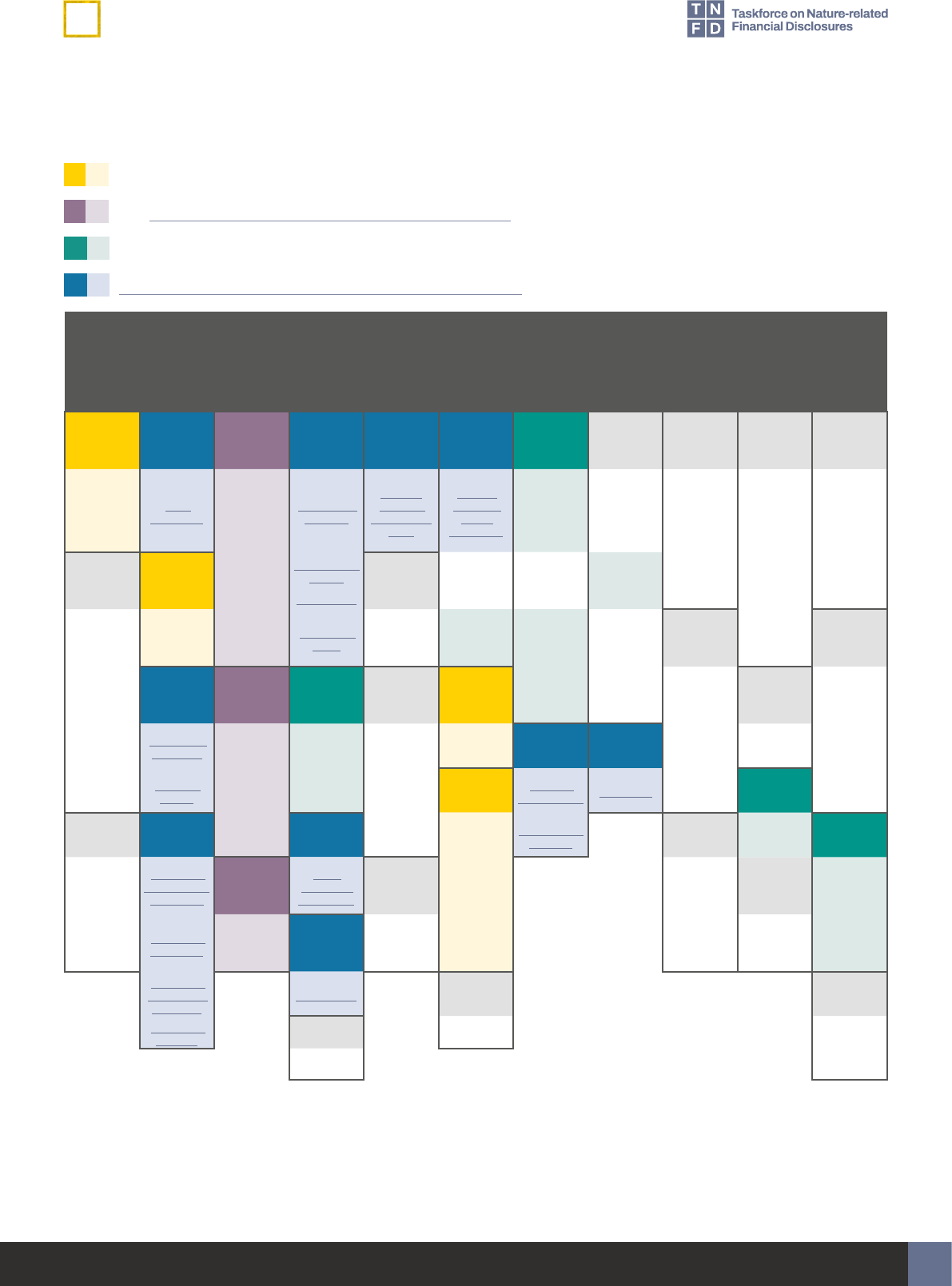
5
Draft sector metrics
For market consultation and feedback – December 2023
Figure 2: Coverage of the TNFD sector guidance, based on SASB’s SICS classication
Sectors with proposed metrics in this discussion paper
See TNFD Additional Guidance for Financial Institutions
Other TNFD priority sectors
Draft metrics published in additional draft sector guidance
Consumer goods
Extractives &
minerals
processing
Financials
Food &
beverage
Health care
Infrastructure
Renewable
resources &
alternative
energy
Resource
transformation
Services
Technology &
communications
Transportation
Apparel &
textiles
Coal
Capital
markets
Food
Biotech-
nology &
pharmaceu-
ticals
Utilities
Alternative
energy
Industrials Media Technology
Air trans-
portation
Apparel,
accessories
& footwear
Coal
operations
Asset man-
agement
& custody
activities
Agricultural
products
Biotech-
nology &
pharmaceu-
ticals
Electric
utilities &
power
generators
Biofuels
Aerospace &
defence
Advertising
& marketing
Electronic
manufactur-
ing services
& original
design man-
ufacturing
Airlines
Consumer
discre-
tionary
products
Construc-
tion mate-
rials
Investment
banking &
brokerage
Meat, poultry
& dairy
Aquaculture
Health care
retail
Gas utilities
& distributors
Fuel cells
& industrial
batteries
Containers &
packaging
Media &
entertain-
ment
Hardware
Air freight &
logistics
Appliance
manufac-
turing
Construction
materials
Security &
commodity
exchanges
Processed
foods
Drug
retailers
Water utilities
& services
Solar
technology
& project
developers
Electrical &
electronic
equipment
Hospitality
& recreation
Software &
IT services
Automo-
biles
Building
products &
furnishings
Metals &
mining
Corporate
& retail
banking
Beverages
Health care
providers
Infrastruc-
ture
Wind
technology
& project
developers
Industrial
machinery &
goods
Casinos &
gaming
Internet
media &
services
Automobiles
Household
& personal
products
Iron & steel
producers
Commercial
banks
Alcoholic
beverages
Health care
delivery
Engineering
& construc-
tion services
Forestry &
paper
Chemicals
Hotels &
lodging
Internet
media &
services
Auto parts
Toys &
sporting
goods
Metals &
mining
Consumer
nance
Non-
alcoholic
beverages
Health care
distributors
Real estate
Forestry
management
Chemicals
Leisure
facilities
Semicon-
ductors
Car rental &
leasing
Consumer
goods retail
Oil & gas
Mortgage
nance
Food &
beverage
retail
Managed
care
Home
builders
Pulp & paper
products
Consumer
services
Semicon-
ductors
Marine
transporta-
tion
Multiline and
speciality
retailers &
distributors
Oil & gas –
exploration &
production
Insurance
Food
retailers &
distributors
Medical
technology
Real estate Education
Telecommu-
nications
Cruise lines
E-commerce
Oil & gas –
midstream
Insurance Restaurants
Medical
equipment &
supplies
Real estate
services
Professional
&
commercial
services
Telecom-
munication
services
Marine trans-
portation
Oil & gas –
rening and
marketing
Restaurants
Waste man-
agement
Land trans-
portation
Oil & gas –
services
Tobacco
Waste
management
Rail trans-
portation
Tobacco
Road trans-
portation
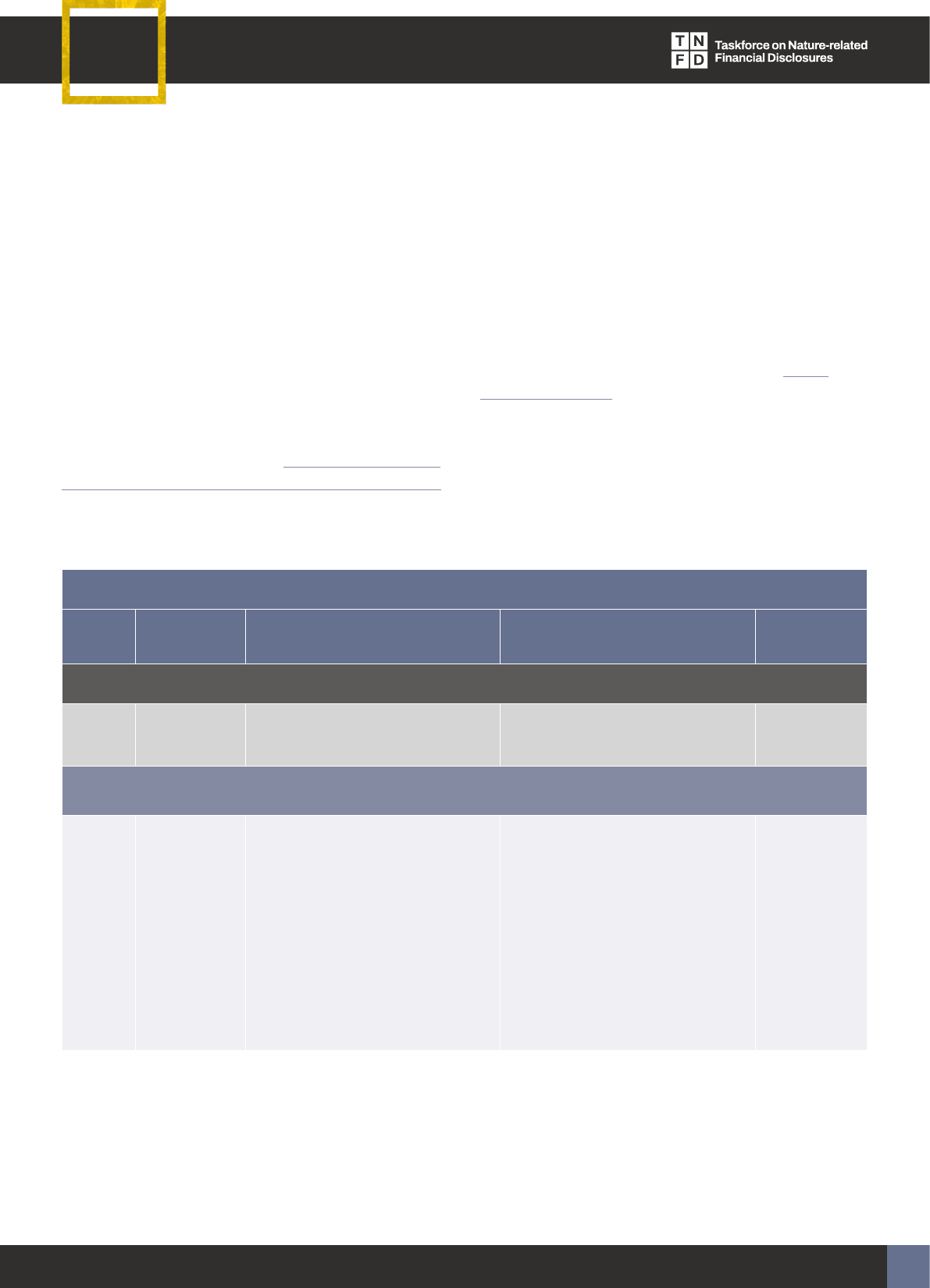
Draft sector metrics
For market consultation and feedback – December 2023
6
Consumer goods
Apparel & textiles
The value chain components for Apparel & textiles
are categorised by tier. Tier 0 corresponds to direct
operations, and Tiers 1-4 correspond to dierent levels
of upstream components. For tiering denitions, see
World Research Institute (2021) Roadmap to Net Zero:
Delivering Science-Based Targets in the Apparel Sector.
Organisations should refer to Annex 1 of the TNFD
Recommendations for further information on the core
global disclosure metrics.
Proposed guidance on the application of the core global disclosure metrics
Apparel & textiles
Metric
no.
Core global
indicator
Core global metric
Proposed guidance for
thissector
Source
Driver of nature change: Climate change
GHG
emissions
Refer to IFRS S2 Climate-related
Disclosure Standard.
No further guidance.
Driver of nature change: Land/freshwater/ocean-use change
C1.0 Total spatial
footprint
Total spatial footprint (km
2
) (sum
of):
• Total surface area controlled/
managed by the organisation,
where the organisation has
control(km
2
);
• Total disturbed area (km
2
);and
• Total rehabilitated/restored area
(km
2
).
No further guidance.

7
Draft sector metrics
For market consultation and feedback – December 2023
Apparel & textiles
Metric
no.
Core global
indicator
Core global metric
Proposed guidance for
thissector
Source
C1.1 Extent
of land/
freshwater/
ocean-use
change
Extent of land/freshwater/ocean
ecosystem use change (km
2
) by:
• Type of ecosystem;
3
and
• Type of business activity.
Tier 4, Upstream
Land-use change to report under
the core global disclosure metric
should include:
• Agriculture-driven terrestrial
natural ecosystem conversion
since 2020,
4
including, at least,
conversion of primary forests,
other naturally regenerating
(second-growth) forests and
freshwater natural ecosystems,
linked to land owned, leased
operated, nanced or
sourcedfrom.
Refer to
Food and
agriculture
metrics
Extent of land/freshwater/ocean
ecosystem conserved or restored
(km
2
), split into:
• Voluntary; and
• Required by statutes or
regulations.
Tier 4, Upstream
The extent conserved or restored
under the core global disclosure
metric should include:
• Area reforested in direct
operations or in the supply
chain of the corporation; and
• Area of wetlands rewetted in
direct operations or supply
chain of the corporation.
Refer to
Food and
agriculture
metrics
Extent of land/freshwater/ocean
ecosystem that is sustainably
managed (km
2
)by:
• Type of ecosystem;
5
and
• Type of business activity.
No further guidance.
3 When disclosing on ecosystem types, refer to the International Union for Conservation of Nature Global Ecosystem Typology.
4 Or other regional or sectoral cuto dates.
5 When disclosing on ecosystem types, refer to the International Union for Conservation of Nature Global Ecosystem Typology.

8
Draft sector metrics
For market consultation and feedback – December 2023
Apparel & textiles
Metric
no.
Core global
indicator
Core global metric
Proposed guidance for
thissector
Source
Driver of nature change: Pollution/pollution removal
C2.0 Pollutants
released to
soil split by
type
Pollutants released to soil
(tonnes) by type, referring to
sector-specic guidance on types
of pollutants
Tier 4, Upstream
Pollutants to report under the core
global disclosure metric should
include:
• Pesticides used by toxicity
hazard level (either extremely
hazardous, highly hazardous,
moderately hazardous,
slightly hazardous, or unlikely
to present an acute hazard)
against baseline.
• Nitrogen balance:
• Nitrogen input from livestock
manure and fertilisers; and
• Nitrogen output.
• Phosphorus balance:
• Phosphorus input; and
• Phosphorus output.
6
• If relevant, balances for
potassium and other nutrients
(e.g. micronutrients).
Refer to
Food and
agriculture
metrics
6 To calculate the nutrient balance minus nutrient inputs with outputs. A negative value indicates risk of soil fertility degradation and a positive
value signals pollution risk.
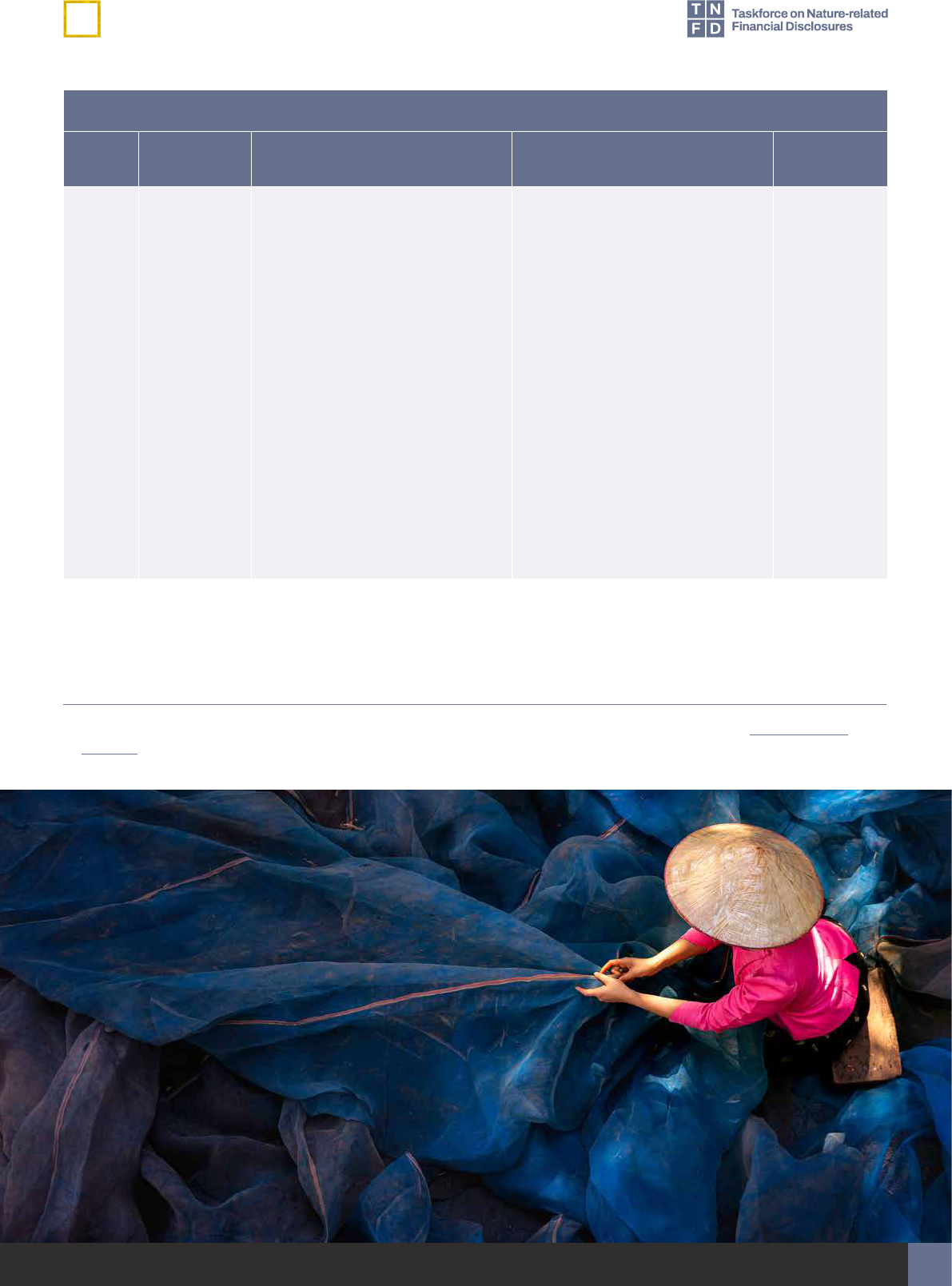
9
Draft sector metrics
For market consultation and feedback – December 2023
Apparel & textiles
Metric
no.
Core global
indicator
Core global metric
Proposed guidance for
thissector
Source
C2.1 Wastewater
discharged
Volume of water discharged (m
3
),
split into:
• Total;
• Freshwater; and
• Other.
7
Including:
• Concentrations of key
pollutants in the wastewater
discharged, by type of pollutant,
referring to sector-specic
guidance for types of pollutants;
and
• Temperature of water
discharged, where relevant.
Tier 0, Direct operations
Pollutants to report under the core
global disclosure metric should
include:
• Nutrients (nitrogen and
phosphorus);
• Pesticides;
• Organic loading (including crop
and livestock excreta);
• Allergenic dyes;
• Pathogens;
• Metals; and
• Other and emerging pollutants
(including antimicrobials and
other veterinary medicines).
Adapted
from TNFD
Food and
agriculture
metrics,
FAIRR Index,
FAO (2017)
7 Freshwater: (≤1,000 mg/L Total Dissolved Solids). Other: (>1,000 mg/L Total Dissolved Solids). Reference: GRI (2018) GRI 303-4 Water
discharge.

10
Draft sector metrics
For market consultation and feedback – December 2023
Apparel & textiles
Metric
no.
Core global
indicator
Core global metric
Proposed guidance for
thissector
Source
C2.2 Waste
generation
and disposal
Weight of hazardous and non-
hazardous waste generated by
type (tonnes), referring to sector-
specic guidance for types of
waste.
Weight of hazardous and non-
hazardous waste (tonnes)
disposed of, split into:
• Waste incinerated (with and
without energy recovery);
• Waste sent to landll; and
• Other disposal methods.
Weight of hazardous and non-
hazardous waste (tonnes) diverted
from landll, split into waste:
• Reused;
• Recycled; and
• Other recovery operations.
Tier 0, Direct operations
In reporting the core global
disclosure metric, an organisation
should include:
• Weight and percentage
of apparel products and
fabric waste by type in the
company’s direct operations,
disaggregated by destination
(e.g. landll or incineration).
In reporting the core global
disclosure metric, an organisation
should:
• Refer to the Sustainable
Apparel Coalition’s Higg
Facility Environmental Module
(FEM) for types of production
hazardous waste (e.g. empty
chemical drums and containers,
expired/used/unused
chemicals).
Sustainable
Apparel
Coalition
(2022)
C2.3 Plastic
pollution
Plastic footprint as measured by
total weight (tonnes) of plastics
(polymers, durable goods and
packaging) used or sold broken
down into the raw material
content.
8
For plastic packaging, percentage
of plastics that is:
• Re-usable;
• Compostable;
• Technically recyclable; and
• Recyclable in practice and at
scale.
Tier 0, Direct operations
In reporting the core global
disclosure metric, an organisation
should include:
• Total weight of plastic
material (primary, secondary
and tertiary) used for textile
products.
TNFD
8 Raw material content: % of virgin fossil-fuel feedstock; % of post-consumer recycled feedstock; % of post-industrial recycled feedstock; % of virgin
renewable feedstock.

11
Draft sector metrics
For market consultation and feedback – December 2023
Apparel & textiles
Metric
no.
Core global
indicator
Core global metric
Proposed guidance for
thissector
Source
C2.4 Non-GHG air
pollutants
Non-GHG air pollutants (tonnes)
by type:
• Particulate matter (PM
2.5
and/
or PM
10
);
• Nitrogen oxides (NO
2
, NO and
NO
3
);
• Volatile organic compounds
(VOC or NMVOC);
• Sulphur oxides (SO
2
, SO, SO
3
,
SO
X
); and
• Ammonia (NH
3
).
Tier 0, Direct operations
In determining additional
pollutants to report under the
core global disclosure metric, an
organisation should refer to the
Sustainable Apparel Coalition’s
Higg Facility Environmental
Module (FEM)’s Air Emissions
2022.
SASB and
Sustainable
Apparel
Coalition
(2022)
Driver of nature change: Resource use/replenishment
C3.0 Water
withdrawal
and
consumption
from areas
of water
scarcity
Water withdrawal and
consumption
9
(m
3
) from areas
of water scarcity, including
identication of water source.
10
No further guidance.
C3.1 Quantity of
high-risk
natural
commodities
sourced from
land/ocean/
freshwater
Quantity of high-risk natural
commodities
11
(tonnes) sourced
from land/ocean/freshwater, split
into types, including proportion of
total natural commodities.
No further guidance.
9 Water consumption is equal to water withdrawal less water discharge. Reference: GRI (2018) GRI 303-5.
10 Surface water; groundwater; seawater; produced water; third-party water. Reference: GRI (2018) GRI 303-3.
11 Users should refer to the Science Based Targets Network (SBTN) High Impact Commodity List (HICL) and indicate what proportion of these
commodities represent threatened and CITES listed species.

12
Draft sector metrics
For market consultation and feedback – December 2023
Apparel & textiles
Metric
no.
Core global
indicator
Core global metric
Proposed guidance for
thissector
Source
C3.1 Quantity of
high-risk
natural
commodities
sourced from
land/ocean/
freshwater
Quantity of high-risk natural
commodities
12
(tonnes) sourced
under a sustainable management
plan or certication programme,
including proportion of total high-
risk natural commodities.
Tier 4, Upstream
In reporting the core global
disclosure metric, an organisation
should include:
• Natural bre or raw material
products on the SBTN High
Impact Commodity List (i.e.
cotton, leather, wool) certied
to a relevant third-party
environmental, social, and/or
animal welfare standard such as
Textile Exchange’s Responsible
Wool Standard (RWS),
Responsible Down Standard
(RDS), Responsible Mohair
Standard (RMS), or Responsible
Alpaca Standard (RAS).
The organisation should specify
which certication applies and the
percentages of certied bres or
raw materials by category.
Adapted from
SASB textile
Driver of nature change: Invasive alien species and other
C4.0 Placeholder
indicator:
Measures
against
unintentional
introduction
of invasive
alien species
(IAS)
13
Proportion of high-risk activities
operated under appropriate
measures to prevent unintentional
introduction of IAS, or low-risk
designed activities.
No further guidance.
12 Users should refer to the Science Based Targets Network (SBTN) High Impact Commodity List (HICL) and indicate what proportion of these
commodities represent threatened and CITES listed species.
13 Due to the measurement of levels of invasive species for organisations being a developing area, the chosen indicator focuses on whether an
appropriate management response is in place for the organisation. The additional sets of metrics contain measurement of the level of invasive
species within an area. The TNFD intends to do further work with experts to dene ‘high-risk activities’ and ‘low-risk designed activities’.

13
Draft sector metrics
For market consultation and feedback – December 2023
Apparel & textiles
Metric
no.
Core global
indicator
Core global metric
Proposed guidance for
thissector
Source
State of nature
C5.0 Placeholder
indicator:
Ecosystem
condition
For those organisations that
choose to report on state of nature
metrics, the TNFD encourages
them to report the following
indicators, and to refer to the
TNFD additional guidance on
measurement of the state of
nature in Annex 2 of the LEAP
approach:
• Level of ecosystem condition
by type of ecosystem and
business activity;
• Impacts on mean species
extinction risk.
There are a number of dierent
measurement options for these
indicators. The TNFD does not
currently specify one metric as
there is no single metric that will
capture all relevant dimensions of
changes to the state of nature and
a consensus is still developing.
The TNFD will continue to work
with knowledge partners to
increase alignment.
No further guidance.
Placeholder
indicator:
Species
extinction
risk
No further guidance.
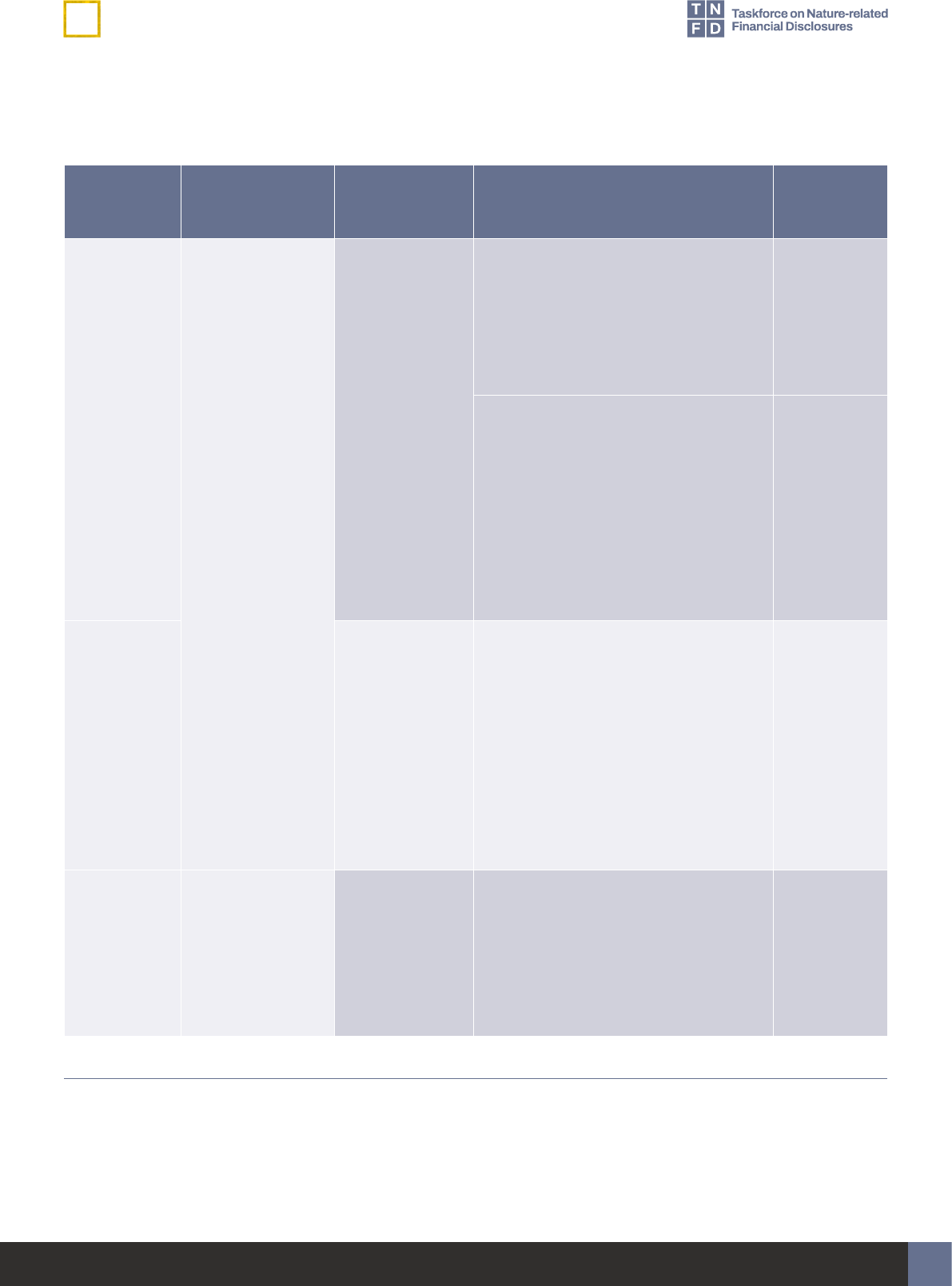
14
Draft sector metrics
For market consultation and feedback – December 2023
Proposed core sector disclosure indicators and metrics – Apparel & textiles
Metric
category
Metric
subcategory
Indicator Proposed core sector disclosure
indicator or metric
Source
Impact driver Land/freshwater/
ocean-use change
Extent of land/
freshwater/
ocean-use
change
Tier 4, Upstream
Percentage of production volume
from land owned, leased, managed
or sourced from determined to be
deforestation-free, by product.
Refer to
Food and
agriculture
metrics
Tier 4, Upstream
Percentage of land managed or sourced
from that deploys practices with
measurable regenerative or sustainable
outcomes. An organisation should
describe and disclose the denition of
regenerative or sustainable agriculture
used for disclosure.
14
Refer to
Food and
agriculture
metrics
Management of
chemicals
Tier 0–4, Upstream and direct
operations
Percentage of chemical products used
in facilities that are certied by the Zero
Discharge of Hazardous Chemicals
Manufacturing Restricted Substances
List (ZDHC MRSL) or equivalent
relevant program such as 4S CHEM
(CHEM 4sustainability protocol).
Adapted from
SASB
CG-AA-
250a.1
Resource use/
replenishment
Quantity of
high-risk natural
commodities
sourced from
land/ocean/
freshwater
Tier 4, Upstream
Percentage of natural bre or raw
material products produced or sourced
from regions with high or extremely high
baseline water stress.
Adapted from
SASB textile
14 The measures start when a baseline has been undertaken for the corporation to track regeneration of environmental assets against, as
disclosure data for the metric.
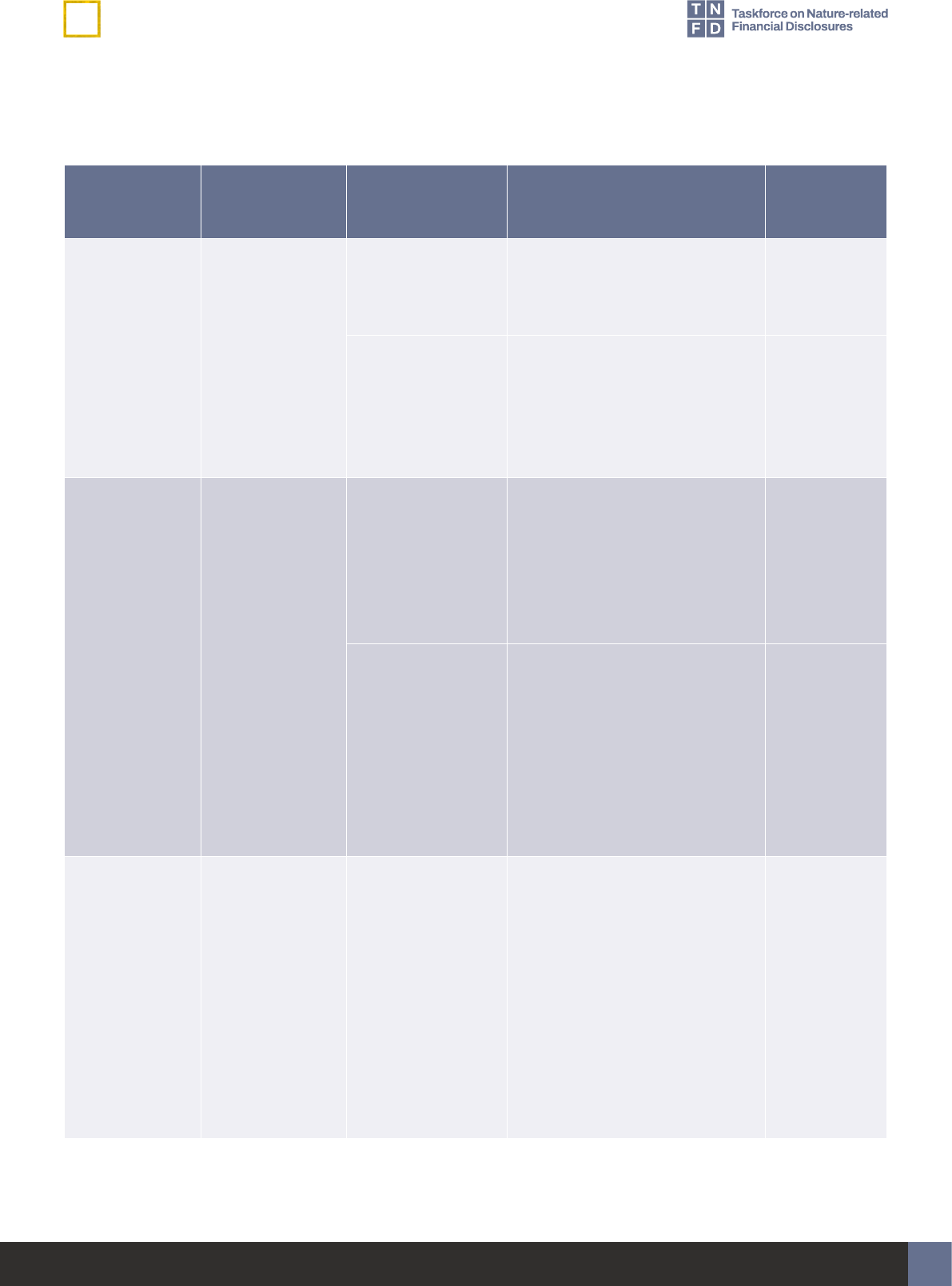
15
Draft sector metrics
For market consultation and feedback – December 2023
Proposed additional sector disclosure indicators and metrics – Apparel & textiles
Metric category Metric
subcategory
Indicator Proposed additional sector
disclosure indicator or metric
Source
Impact driver Pollution/pollution
removal
Waste Percentage of unsold apparel
products in all selling points that
are recycled or given away (%).
TNFD
Plastic pollution Total weight of plastics (tonnes)
commonly classied as
problematic (PS, PVC, EPC,
multilayer plastic packaging,
undetectable carbon black).
TNFD
Response Dependency,
impact, risk and
opportunity
management
Dependency,
impact, risk and
opportunity
assessment
Company’s bre and raw material
product composition (tonnes) and
the share (%) of priority material
(e.g. cotton, leather, wool,
polyester), indicating whether
each is from recycled sources.
Textile
Exchange
Corporate
Benchmark
Voluntary
conservation,
restoration and
regeneration
Area (km
2
) of land used (for
agriculture, grazing and/
or forestry) that employs
regenerative practices with
measurable regenerative
outcomes, referencing the
denition used (e.g. from OP2B or
Textile Exchange).
Related to
GBF target 10
State of nature Ecosystem extent
and condition
Ecosystem
condition
Concentration of key pollutants
around key water basins in which
the company is operating, by
type (m
3
or equivalent): nutrients
(nitrogen and phosphorus levels),
pesticides, organic loading
(including crop and livestock
excreta), pathogens, metals,
other and emerging pollutants
(including antibiotics and other
veterinarymedicines).
Adapted from
FAIRR (2022),
FAO (2017)

Draft sector metrics
For market consultation and feedback – December 2023
16
Extractives & minerals processing
Construction materials
The TNFD recognises the important contributions from
this sector to habitat fragmentation and noise pollution.
The TNFD encourages organisations to measure these
impact drivers and would welcome feedback on industry
best practices. In particular:
• How can metrics like the Singapore Index be applied
in a corporate reporting context in this sector?
• How do organisations in this sector currently measure
noise pollution? At what times of day? Is pitch
alsomonitored?
• What noise metrics would be most appropriate to
understand the impact of human noise generation
onnature?
Organisations should refer to Annex 1 of the TNFD
Recommendations for further information on the core
global disclosure metrics.
Proposed guidance on the application of the core global disclosure metrics
Construction materials
Metric
no.
Core global
indicator
Core global metric
Proposed guidance for
thissector
Source
Driver of nature change: Climate change
GHG
emissions
Refer to IFRS S2 Climate-related
Disclosure Standard.
No further guidance.
Driver of nature change: Land/freshwater/ocean-use change
C1.0 Total spatial
footprint
Total spatial footprint (km
2
) (sum
of):
• Total surface area controlled/
managed by the organisation,
where the organisation has
control (km
2
);
• Total disturbed area (km
2
); and
• Total rehabilitated/restored area
(km
2
).
The land footprint under the core
global disclosure metric should
include land owned, leased or
managed in the exploration,
development and production, or
quarry/mine closure, and post-
closure project phases.
GRI 304-1

17
Draft sector metrics
For market consultation and feedback – December 2023
Construction materials
Metric
no.
Core global
indicator
Core global metric
Proposed guidance for
thissector
Source
C1.1 Extent
of land/
freshwater/
ocean-use
change
Extent of land/freshwater/ocean
ecosystem use change (km
2
) by:
• Type of ecosystem;
15
and
• Type of business activity.
In reporting the core global
disclosure metric, land-use
change should cover the gross
area disturbed in the reporting
period. This includes land in
the exploration, development
and production, or quarry/mine
closure, and post-closure project
phases.
SASB (2019)
EM-CM-
160a.2; GRI
304-3
Extent of land/freshwater/ocean
ecosystem conserved or restored
(km
2
), split into:
• Voluntary; and
• Required by statutes or
regulations.
The extent conserved or restored
reported under the core global
disclosure metric should include
only activity within the value chain.
TNFD
Extent of land/freshwater/ocean
ecosystem that is sustainably
managed (km
2
) by:
• Type of ecosystem;
16
and
• Type of business activity.
No further guidance.
15 When disclosing on ecosystem types, refer to the International Union for Conservation of Nature Global Ecosystem Typology.
16 When disclosing on ecosystem types, refer to the International Union for Conservation of Nature Global Ecosystem Typology.

18
Draft sector metrics
For market consultation and feedback – December 2023
Construction materials
Metric
no.
Core global
indicator
Core global metric
Proposed guidance for
thissector
Source
Driver of nature change: Pollution/pollution removal
C2.0 Pollutants
released to
soil split by
type
Pollutants released to soil
(tonnes) by type, referring to
sector-specic guidance on types
of pollutants.
No further guidance. TNFD
C2.1 Wastewater
discharged
Volume of water discharged (m
3
),
split into:
• Total;
• Freshwater; and
• Other.
17
Including:
• Concentrations of key
pollutants in the wastewater
discharged, by type of pollutant,
referring to sector-specic
guidance for types of pollutants;
and
• Temperature of water
discharged, where relevant.
Reporting of water discharged
under the core global disclosure
metric should additionally be
broken down by destination:
• Surface water;
• Groundwater;
• Seawater; and
• Third-party water, and the
volume of this total sent for use
to other organisations.
Pollutants and water quality
metrics to report under the core
global disclosure metric include:
• pH;
• TSS (Total Suspended Solids);
• TDS (Total Dissolved Solids);
• Mercury;
• TPH (Total Petroleum
Hydrocarbons);
• BOD (Biochemical Oxygen
Demand);
• Dissolved solids; and
• Suspended solids.
GRI 303-4;
ENCORE
17 Freshwater: (≤1,000 mg/L Total Dissolved Solids). Other: (>1,000 mg/L Total Dissolved Solids). Reference: GRI (2018)
GRI 303-4 Water discharge.

19
Draft sector metrics
For market consultation and feedback – December 2023
Construction materials
Metric
no.
Core global
indicator
Core global metric
Proposed guidance for
thissector
Source
C2.2 Waste
generation
and disposal
Weight of hazardous and non-
hazardous waste generated by
type (tonnes), referring to sector-
specic guidance for types of
waste.
Weight of hazardous and non-
hazardous waste (tonnes)
disposed of, split into:
• Waste incinerated (with and
without energy recovery);
• Waste sent to landll; and
• Other disposal methods.
Weight of hazardous and non-
hazardous waste (tonnes)
diverted from landll, split into
waste:
• Reused;
• Recycled; and
• Other recovery operations.
Types of waste to report under
the core global disclosure metric
include:
• Slags, dusts, sludges, used oil,
other solid waste that meet the
TNFD denition of waste.
SASB (2018)
construction
materials:
EM-CM-
150a.1
GRI (2022)
GRI
Standards
Glossary
C2.3 Plastic
pollution
Plastic footprint as measured by
total weight (tonnes) of plastics
(polymers, durable goods and
packaging) used or sold broken
down into the raw material
content.
18
For plastic packaging, percentage
of plastics that is:
• Re-usable;
• Compostable;
• Technically recyclable; and
• Recyclable in practice and at
scale.
No further guidance.
18 Raw material content: % of virgin fossil-fuel feedstock; % of post-consumer recycled feedstock; % of post-industrial recycled feedstock; % of
virgin renewable feedstock.

20
Draft sector metrics
For market consultation and feedback – December 2023
Construction materials
Metric
no.
Core global
indicator
Core global metric
Proposed guidance for
thissector
Source
C2.4 Non-GHG air
pollutants
Non-GHG air pollutants (tonnes)
by type:
• Particulate matter (PM
2.5
and/
or PM
10
);
• Nitrogen oxides (NO
2
, NO and
NO
3
);
• Volatile organic compounds
(VOC or NMVOC);
• Sulphur oxides (SO
2
, SO, SO
3
,
SO
X
); and
• Ammonia (NH
3
).
Additional pollutants to report
under the core global disclosure
metric include:
• Carbon monoxide (CO);
• Dioxins/furans, including but
not limited to the sum of the 17
congeners of polychlorinated
dibenzodioxins (PCDDs) and
polychlorinated dibenzofurans
(PCDFs) that contain
chlorine;and
• Heavy metals (includes mercury
(Hg), cadmium (Cd), thallium
(Tl), antimony (Sb), arsenic
(As), lead (Pb), chromium
(Cr), cobalt (Co), copper (Cu),
manganese (Mn), nickel (Nl) and
vanadium(V).
TNFD

21
Draft sector metrics
For market consultation and feedback – December 2023
Construction materials
Metric
no.
Core global
indicator
Core global metric
Proposed guidance for
thissector
Source
Driver of nature change: Resource use/replenishment
C3.0 Water
withdrawal
and
consumption
from areas
of water
scarcity
Water withdrawal and
consumption
19
(m
3
) from areas
of water scarcity, including
identication of water source.
20
In reporting the core global
disclosure metric, an organisation
should include:
• Total freshwater (≤1000 mg/l
of Total Dissolved Solids)
withdrawal, including from
natural open sources such
as rivers, lakes, natural
ponds, streams, creeks; from
groundwater (wells, boreholes,
water below soil surface); from
municipal and/or from third
parties; from quarry dewatering
used in operations;
• Total non-freshwater (>1000
mg/l of Total Dissolved Solids)
withdrawal, including from
sources of high salinity or
pollutants; and
• Harvested rainwater: Volume
of precipitation (rainwater or
snowmelt) that is collected
onsite (e.g. settling ponds,
inactive quarry area that has not
yet reached the groundwater
table).
Water from quarry dewatering that
is not used should be reported
separately.
An organisation should dierentiate
withdrawal from groundwater
sources that are recharged and
non-recharged.
GCCA
(2019)
GRI-303-4
GRI-G4
Construction
& Real
Estate
Disclosures
EN8-EN9
SASB Real
Estate IF-
RE-140a.1.,
IF-RE-
140a.2., IF-
RE-140a.3.
Recharged
groundwater
from GRI, as
above
19 Water consumption is equal to water withdrawal less water discharge. Reference: GRI (2018) GRI 303-5.
20 Surface water; groundwater; seawater; produced water; third-party water. Reference: GRI (2018) GRI 303-3.

22
Draft sector metrics
For market consultation and feedback – December 2023
Construction materials
Metric
no.
Core global
indicator
Core global metric
Proposed guidance for
thissector
Source
C3.1 Quantity of
high-risk
natural
commodities
sourced from
land/ocean/
freshwater
Quantity of high-risk natural
commodities
21
(tonnes) sourced
from land/ocean/freshwater, split
into types, including proportion of
total natural commodities.
Commodities to report under
the core global disclosure metric
include: limestone chalk marl,
silica correctives, alumina and
ferrous, natural gypsum, pozzolan,
primary aggregates, sand, and
coal.
TNFD;
GRI-G4 Real
Estate &
Construction,
G4-EN1;
SBTN High
Impact
Commodity
list
Quantity of high-risk natural
commodities
22
(tonnes) sourced
under a sustainable management
plan or certication programme,
including proportion of total high-
risk natural commodities.
Driver of nature change: Invasive alien species and other
C4.0 Placeholder
indicator:
Measures
against
unintentional
introduction
of invasive
alien species
(IAS)
23
Proportion of high-risk activities
operated under appropriate
measures to prevent unintentional
introduction of IAS, or low-risk
designed activities.
No further guidance. TNFD;
GRI-G4 Real
Estate &
Construction,
G4-EN1;
SBTN High
Impact
Commodity
list
21 Users should refer to the Science Based Targets Network (SBTN) High Impact Commodity List (HICL) and indicate what proportion of these
commodities represent threatened and CITES listed species.
22 Users should refer to the Science Based Targets Network (SBTN) High Impact Commodity List (HICL) and indicate what proportion of these
commodities represent threatened and CITES listed species.
23 Due to the measurement of levels of invasive species for organisations being a developing area, the chosen indicator focuses on whether an
appropriate management response is in place for the organisation. The additional sets of metrics contain measurement of the level of invasive
species within an area. The TNFD intends to do further work with experts to dene ‘high-risk activities’ and ‘low-risk designed activities’.

23
Draft sector metrics
For market consultation and feedback – December 2023
Construction materials
Metric
no.
Core global
indicator
Core global metric
Proposed guidance for
thissector
Source
State of nature
C5.0 Placeholder
indicator:
Ecosystem
condition
For those organisations that
choose to report on state of nature
metrics, the TNFD encourages
them to report the following
indicators, and to refer to the
TNFD additional guidance on
measurement of the state of
nature in Annex 2 of the LEAP
approach:
• Level of ecosystem condition
by type of ecosystem and
business activity;
• Species extinction risk.
There are a number of dierent
measurement options for these
indicators. The TNFD does not
currently specify one metric as
there is no single metric that will
capture all relevant dimensions of
changes to the state of nature and
a consensus is still developing.
The TNFD will continue to work
with knowledge partners to
increase alignment.
No further guidance.
Placeholder
indicator:
Species
extinction
risk

24
Draft sector metrics
For market consultation and feedback – December 2023
Proposed core sector disclosure indicators and metrics – Construction materials
Metric category Metric subcategory Indicator Proposed core sector
disclosure indicator or metric
Source
Impact driver Pollution/pollution removal Spills Volume of spills of diesel, paints,
solvents and toxic chemicals
(m
3
), by national or company
spill classication scheme and
by type of ecosystem aected.
GRI 303-4;
ENCORE

25
Draft sector metrics
For market consultation and feedback – December 2023
Proposed additional sector disclosure indicators and metrics – Construction materials
Metric
category
Metric
subcategory
Indicator Proposed additional sector disclosure
indicator or metric
Source
Impact driver Pollution/
pollution removal
Disturbances Average light pollution levels, measured,
for example by:
• Night sky light pollution levels on the
Sky Quality Meter (SQM) Scale or Bortle
scale;
• Percentage of light xtures that fully cut-
o or fully shielded or below 60W; or
• Outdoor lighting (lumen/ha).
IUCN (2023)
Urban Nature
Indexes
Response Dependency,
impact, risk and
opportunity
management
General Proportion of materials used that are
recycled and reused input materials by
signicant categories of raw materials,
renewable materials and manufactured
products (%);
or
Share of total mass of materials, products
and components/systems for the new
build/refurbishment/t-out that have been
reused, repurposed or remanufactured,
either from the building undergoing
demolition, refurbishment, t-out or from
other buildings, third parties etc. (%).
GRI: G4-EN2
Percentage
of materials
used that are
recycled input
materials
UK Green
Building
Council
(2023)
Response Dependency,
impact, risk and
opportunity
management
General Total volume of water volume that has
been sustainably supplied, puried and/
or conserved in the same watershed
where the freshwater was withdrawn. This
includes volume of water from watershed
protection and restoration projects, from
water access and sanitation to community
projects and from water ecient agriculture
and water ecient irrigation practices.
TNFD

Draft sector metrics
For market consultation and feedback – December 2023
26
Infrastructure
Infrastructure; Real estate
The TNFD recognises the important contributions from
this sector to habitat fragmentation and noise pollution.
The TNFD encourages organisations to measure these
impact drivers and would welcome feedback on industry
best practices. In particular:
• How can metrics like the Singapore Index be applied
to a corporate reporting context in this sector?
• How do organisations in this sector currently measure
noise pollution? At what times of day? Is pitch also
monitored?
• What noise metrics would be most appropriate to
understand the impact of human noise generation on
nature?
Organisations should refer to Annex 1 of the TNFD
Recommendations for further information on the core
global disclosure metrics.
Proposed guidance on the application of the core global disclosure metrics
Engineering & construction services; Home builders; Real estate; Real estate services
Metric
no.
Core global
indicator
Core global metric Proposed guidance for
thissector
Source
Driver of nature change: Climate change
GHG
emissions
Refer to IFRS S2 Climate-related
Disclosure Standard.
No further guidance.
Driver of nature change: Land/freshwater/ocean-use change
C1.0 Total spatial
footprint
Total spatial footprint (km
2
)
(sumof):
• Total surface area controlled/
managed by the organisation,
where the organisation has
control (km
2
);
• Total disturbed area (km
2
); and
• Total rehabilitated/restored
area(km
2
).
Engineering & construction
services; Home builders; Real
estate; Real estate services
The land footprint under the core
global disclosure metric should
include land owned, leased or
managed.
GRI 304-1

27
Draft sector metrics
For market consultation and feedback – December 2023
Engineering & construction services; Home builders; Real estate; Real estate services
Metric
no.
Core global
indicator
Core global metric Proposed guidance for
thissector
Source
C1.1 Extent
of land/
freshwater/
ocean-use
change
Extent of land/freshwater/ocean
ecosystem use change (km
2
) by:
• Type of ecosystem;
24
and
• Type of business activity.
Engineering & construction
services; Home builders
Land-use change reported under
the core global disclosure metric
should distinguish land-use
changes by original land uses:
browneld sites, undeveloped
land, farmland, wetland etc.
Real estate; Real estate
services
No further guidance.
SASB (2019)
EM-CM-
160a.2; GRI
304-3
Land-use
change –
Adapted
from SITES
v2 Rating
System for
Sustainable
Land
Design and
Development
Extent of land/freshwater/ocean
ecosystem conserved or restored
(km
2
), split into:
• Voluntary; and
• Required by statutes or
regulations.
Engineering & construction
services; Home builders; Real
estate; Real estate services
The extent conserved or restored
under the core global disclosure
metric should include only activity
within the value chain.
TNFD
Extent of land/freshwater/ocean
ecosystem that is sustainably
managed (km
2
)by:
• Type of ecosystem;
25
and
• Type of business activity.
Engineering & construction
services; Home builders; Real
estate; Real estate services
No further guidance.
24 When disclosing on ecosystem types, refer to the International Union for Conservation of Nature Global Ecosystem Typology.
25 When disclosing on ecosystem types, refer to the International Union for Conservation of Nature Global Ecosystem Typology.

28
Draft sector metrics
For market consultation and feedback – December 2023
Engineering & construction services; Home builders; Real estate; Real estate services
Metric
no.
Core global
indicator
Core global metric Proposed guidance for
thissector
Source
Driver of nature change: Pollution/pollution remova
C2.0 Pollutants
released
to soil split
bytype
Pollutants released to soil
(tonnes) by type, referring to
sector-specic guidance on types
of pollutants
Engineering & construction
services; Home builders
No further guidance.
Real estate; Real estate
services
Pollutants to report under the core
global disclosure metric include:
• Volume of pesticides used by
toxicity hazard level (either
extremely hazardous, highly
hazardous, moderately
hazardous, slightly hazardous,
or unlikely to present an acute
hazard) against baseline;
• Chemical nitrogen fertilisers
input by source (tonnes of
nitrogen);
• Mineral phosphorus fertilisers
input by source (tonnes of
phosphorus); and
• Total manure and
compostinput.
TNFD; WHO
(2019)

29
Draft sector metrics
For market consultation and feedback – December 2023
Engineering & construction services; Home builders; Real estate; Real estate services
Metric
no.
Core global
indicator
Core global metric Proposed guidance for
thissector
Source
C2.1 Wastewater
discharged
Volume of water discharged (m
3
),
split into:
• Total;
• Freshwater; and
• Other.
26
Including:
• Concentrations of key
pollutants in the wastewater
discharged, by type of pollutant,
referring to sector-specic
guidance for types of pollutants;
and
• Temperature of water
discharged, where relevant.
Engineering & construction
services; Home builders
Reporting of water discharged
under the core global disclosure
metric should additionally be
broken down by destination:
• Surface water;
• Groundwater;
• Seawater; and
• Third-party water, and the
volume of this total sent for use
to other organisations.
Real estate; Real estate
services
Reporting of water discharged
under the core global disclosure
metric should additionally be
broken down by destination:
• Surface water;
• Groundwater;
• Seawater; and
• Third-party water, and the
volume of this total sent for use
to other organisations.
Pollutants to report under the core
global disclosure metric include:
• Dissolved solids; and
• Suspended solids.
GRI 303-4;
ENCORE
26 Freshwater: (≤1,000 mg/L Total Dissolved Solids). Other: (>1,000 mg/L Total Dissolved Solids). Reference: GRI (2018) GRI 303-4
Waterdischarge.

30
Draft sector metrics
For market consultation and feedback – December 2023
Engineering & construction services; Home builders; Real estate; Real estate services
Metric
no.
Core global
indicator
Core global metric Proposed guidance for
thissector
Source
C2.2 Waste
generation
and disposal
Weight of hazardous and non-
hazardous waste generated by
type (tonnes), referring to sector-
specic guidance for types of
waste.
Weight of hazardous and non-
hazardous waste (tonnes)
disposed of, splitinto:
• Waste incinerated (with and
without energy recovery);
• Waste sent to landll; and
• Other disposal methods.
Weight of hazardous and non-
hazardous waste (tonnes)
diverted from landll, split into
waste:
• Reused;
• Recycled; and
• Other recovery operations.
Engineering & construction
services; Home builders; Real
estate; Real estate services
Types of waste to report under
the core global disclosure metric
include:
• Slags, dusts, sludges, used oil,
other solid waste that meet the
TNFD denition of waste.
SASB (2018)
construction
materials:
EM-CM-
150a.1
GRI (2022)
GRI
Standards
Glossary

31
Draft sector metrics
For market consultation and feedback – December 2023
Engineering & construction services; Home builders; Real estate; Real estate services
Metric
no.
Core global
indicator
Core global metric Proposed guidance for
thissector
Source
C2.3 Plastic
pollution
Plastic footprint as measured by
total weight (tonnes) of plastics
(polymers, durable goods and
packaging) used or sold broken
down into the raw material
content.
27
For plastic packaging, percentage
of plastics thatis:
• Re-usable;
• Compostable;
• Technically recyclable; and
• Recyclable in practice and at
scale.
Engineering & construction
services; Home builders; Real
estate; Real estate services
No further guidance.
C2.4 Non-GHG air
pollutants
Non-GHG air pollutants (tonnes)
by type:
• Particulate matter (PM
2.5
and/
or PM
10
);
• Nitrogen oxides (NO
2
, NO and
NO
3
);
• Volatile organic compounds
(VOC or NMVOC);
• Sulphur oxides (SO
2
, SO, SO
3
,
SO
X
); and
• Ammonia (NH
3
).
Engineering & construction
services; Home builders; Real
estate; Real estate services
No further guidance.
27 Raw material content: % of virgin fossil-fuel feedstock; % of post-consumer recycled feedstock; % of post-industrial recycled feedstock; % of
virgin renewable feedstock.

32
Draft sector metrics
For market consultation and feedback – December 2023
Engineering & construction services; Home builders; Real estate; Real estate services
Metric
no.
Core global
indicator
Core global metric Proposed guidance for
thissector
Source
Driver of nature change: Resource use/replenishment
C3.0 Water
withdrawal
and
consumption
from areas
of water
scarcity
Water withdrawal and
consumption
28
(m
3
) from areas
of water scarcity, including
identication of water source.
29
Engineering & construction
services; Home builders
In reporting the core global metric,
an organisation should include:
• Known or metered water
withdrawal and consumption in
addition to listing non-metered
sources (e.g. seepage of
ground water in tunnels); and
• Water withdrawal from:
greywater, blackwater, treated
wastewater, desalination plants
and other water sources, as well
as total water withdrawal and
consumption.
This should cover all water
purchased and sourced but
may include itemisation of water
allocated to other parties as
the end user. The organisation
should dierentiate between water
withdrawal from groundwater
sources that are recharged and
non-recharged.
GRI-303-4
GRI-G4
Construction
& Real Estate
Disclosures
EN8-EN9
SASB Real
Estate IF-
RE-140a.1.,
IF-RE-
140a.2., IF-
RE-140a.3.
Recharged
groundwater
from GRI, as
above
28 Water consumption is equal to water withdrawal less water discharge. Reference: GRI (2018) GRI 303-5.
29 Surface water; groundwater; seawater; produced water; third-party water. Reference: GRI (2018) GRI 303-3.

33
Draft sector metrics
For market consultation and feedback – December 2023
Engineering & construction services; Home builders; Real estate; Real estate services
Metric
no.
Core global
indicator
Core global metric Proposed guidance for
thissector
Source
Real estate; Real estate
services
In reporting the core global metric,
an organisation should include:
• The share of total oor area for
which water withdrawal data
have been obtained;
• Water withdrawal by portfolio
area with data covered; and
• Water withdrawal from:
greywater, blackwater, treated
waste water, desalination plants
and other water sources, as well
as total water withdrawal and
consumption.
This should cover all water
purchased and sourced, but
may include itemisation of water
allocated to other parties as
the end user. The organisation
should dierentiate between water
withdrawal from groundwater
sources that are recharged and
non-recharged.

34
Draft sector metrics
For market consultation and feedback – December 2023
Engineering & construction services; Home builders; Real estate; Real estate services
Metric
no.
Core global
indicator
Core global metric Proposed guidance for
thissector
Source
C3.1 Quantity of
high-risk
natural
commodities
sourced from
land/ocean/
freshwater
Quantity of high-risk natural
commodities
30
(tonnes) sourced
from land/ocean/freshwater, split
into types, including proportion of
total natural commodities.
Engineering & construction
services; Home builders
Commodities to report under
the core global disclosure metric
include:
• Natural commodities:
aluminium, copper, gypsum,
iron, lead, sand and timber; and
• Manufactured commodities:
brick, cement, concrete, carpet,
glass, insulation products,
rubber and steel.
Real estate; Real estate
services
• No further guidance.
GRI-G4 Real
Estate &
Construction
G4-EN1,
SBTN High
Impact
Commodity
list
Quantity of high-risk natural
commodities
31
(tonnes) sourced
under a sustainable management
plan or certication programme,
including proportion of total high-
risk natural commodities.
Driver of nature change: Invasive alien species and other
C4.0 Placeholder
indicator:
Measures
against
unintentional
introduction
of invasive
alien species
(IAS)
32
Proportion of high-risk activities
operated under appropriate
measures to prevent unintentional
introduction of IAS, or low-risk
designed activities.
Engineering & construction
services; Home builders; Real
estate; Real estate services
No further guidance.
30 Users should refer to the Science Based Targets Network (SBTN) High Impact Commodity List (HICL) and indicate what proportion of these
commodities represent threatened and CITES listed species.
31 Users should refer to the Science Based Targets Network (SBTN) High Impact Commodity List (HICL) and indicate what proportion of these
commodities represent threatened and CITES listed species.
32 Due to the measurement of levels of invasive species for organisations being a developing area, the chosen indicator focuses on whether an
appropriate management response is in place for the organisation. The additional sets of metrics contain measurement of the level of invasive
species within an area. The TNFD intends to do further work with experts to dene ‘high-risk activities’ and ‘low-risk designed activities’.

35
Draft sector metrics
For market consultation and feedback – December 2023
Engineering & construction services; Home builders; Real estate; Real estate services
Metric
no.
Core global
indicator
Core global metric Proposed guidance for
thissector
Source
State of nature
C5.0 Placeholder
indicator:
Ecosystem
condition
For those organisations that
choose to report on state of nature
metrics, the TNFD encourages
them to report the following
indicators, and to refer to the
TNFD additional guidance on
measurement of the state of
nature in Annex 2 of the LEAP
approach:
• Level of ecosystem condition
by type of ecosystem and
business activity;
• Species extinction risk.
There are a number of dierent
measurement options for these
indicators. The TNFD does not
currently specify one metric as
there is no single metric that will
capture all relevant dimensions of
changes to the state of nature and
a consensus is still developing.
The TNFD will continue to work
with knowledge partners to
increase alignment.
Engineering & construction
services; Home builders; Real
estate; Real estate services
No further guidance.
Placeholder
indicator:
Species
extinction
risk
Engineering & construction
services; Home builders; Real
estate; Real estate services
No further guidance.

36
Draft sector metrics
For market consultation and feedback – December 2023
Proposed core sector disclosure indicators and metrics –
Engineering & construction services; Home builders; Real estate; Real estate services
Metric category Metric
subcategory
Indicator Proposed core sector disclosure
indicator or metric
Source
Impact driver Land/
freshwater/
ocean-use
change
Change to
connectivity
Engineering & construction services
Length (km) of linear infrastructure (e.g.
rail, road, fencing) built outside urban
areas by type, width (e.g. number of
lanes or tracks; metres) and surfacing.
TNFD
Impact driver Engineering & construction services
Number of fragmentation mitigation
measures (e.g. animal crossing points)
constructed for linear infrastructure
(count).
TNFD
Impact driver Pollution/
pollution
removal
Spills of
pollutants
Engineering & construction services;
Home builders
Volume of spills of diesel, paints,
solvents, and toxic chemicals
(m
3
), by national or company spill
classication scheme and by type of
ecosystemaected.
GRI 303-4;
ENCORE
Impact driver Resource use/
replenishment
Quantity
of high-
risk natural
commodities
sourced from
land/ocean/
freshwater
Engineering & construction services;
Home builders
Percentage of timber procured that is
from threatened species.
Based on
SITES v2
Rating
System for
Sustainable
Land
Design and
Development,
5.1
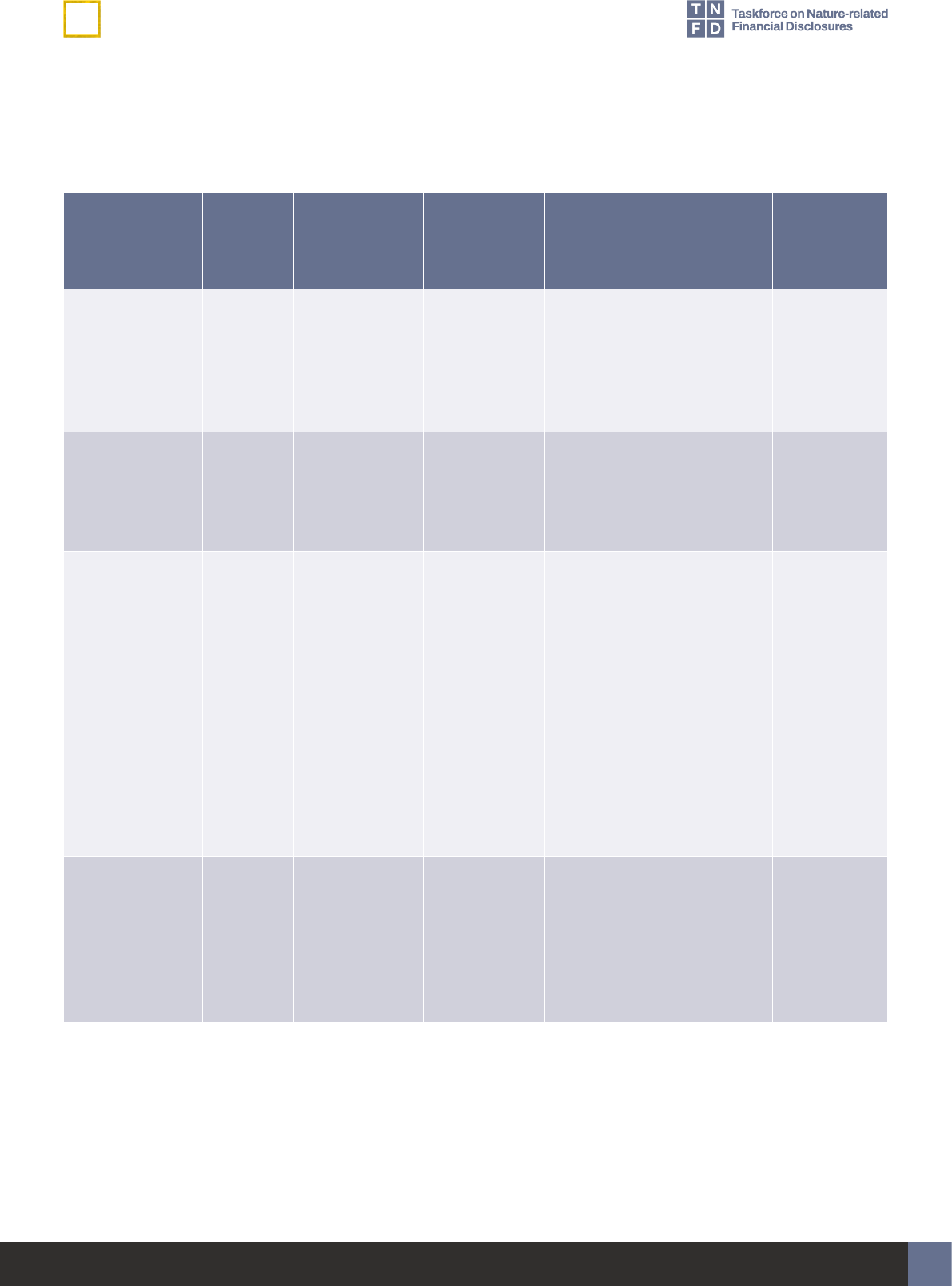
37
Draft sector metrics
For market consultation and feedback – December 2023
Proposed additional sector disclosure indicators and metrics –
Engineering & construction services; Home builders; Real estate; Real estate services
Sector Metric
category
Metric
subcategory
Indicator Proposed additional sector
disclosure indicator or
metric
Source
Engineering &
construction
services; Home
builders
Impact
driver
Land/
freshwater/
ocean-use
change
Land-use
change
Soil erosion on sites (m
3
),
measured as the average
change in soil depth,
multiplied by the area under
management.
TNFD
Engineering &
construction
services; Home
builders
Impact
driver
Land/
freshwater/
ocean-use
change
Land-use
change
Area of soil restored to a
minimum depth of 30.48cm
following disturbance by
construction activities (m
2
).
SITES Rating
system 7.3
and 7.4
Engineering &
construction
services; Home
builders; Real
estate; Real
estate services
Impact
driver
Pollution/
pollution
removal
Disturbances Average light pollution levels,
measured, for example, by:
• Night sky light pollution
levels on the Sky Quality
Meter (SQM) Scale or
Bortle scale;
• Percentage of light xtures
that fully cut-o or fully
shielded or below 60W; or
• Outdoor lighting
(lumen/ha).
IUCN (2023)
Urban Nature
Indexes
Engineering &
construction
services; Home
builders; Real
estate; Real
estate services
Impact
driver
Invasive
species and
other
Biological
alterations
Area of land owned,
controlled, managed or
leased cleared of invasive
species during reporting
period (km
2
).
TNFD
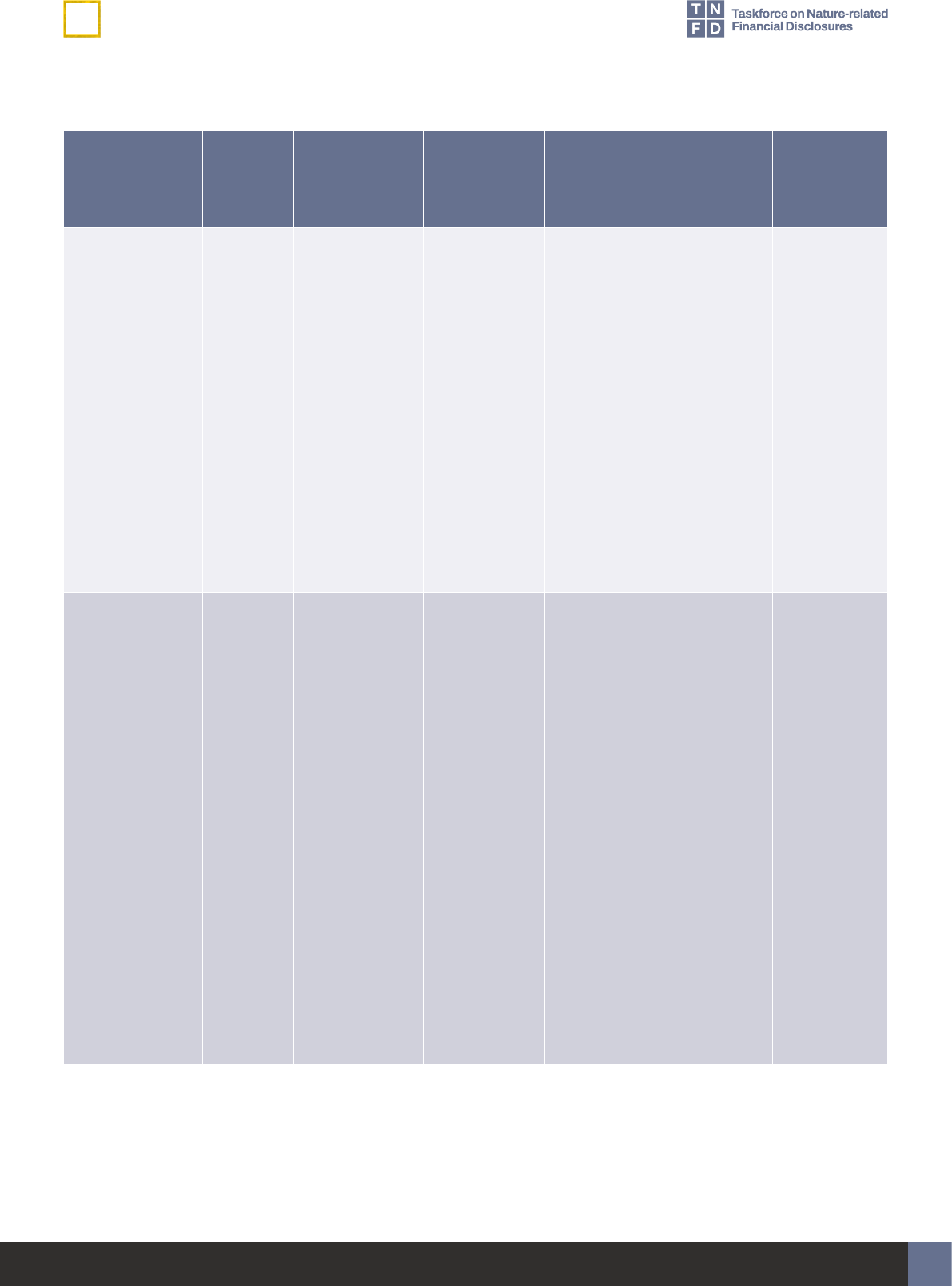
38
Draft sector metrics
For market consultation and feedback – December 2023
Sector Metric
category
Metric
subcategory
Indicator Proposed additional sector
disclosure indicator or
metric
Source
Engineering &
construction
services; Home
builders; Real
estate; Real
estate service
State of
nature
Ecosystem
extent and
condition
Urban
green space
created.
Potential measures could
include:
• Green plot ratio;
• Urban greening factor;
• Area of tree planting (m
2
);
• Area of a building on which
plants are planted (m
2
);
• Share of area above
threshold for normalised
dierence vegetation
index; and
• Number of areas of
sections of planted trees of
more than 100m
2
created.
Ong (2003);
The Ecology
Consultancy
(2017); IUCN
Urban Nature
Indexes; HTT
Tokyo Green
Building
Program
for New
Buildings
Engineering &
construction
services; Home
builders; Real
estate; Real
estate service
Response Dependency,
impact, risk and
opportunity
management
General Proportion of materials used
that are recycled and reused
input materials by signicant
categories of raw materials,
renewable materials and
manufactured products (%);
or
Share of total mass of
materials, products and
components/systems for
the new build/refurbishment/
t-out that have been
reused, repurposed or
remanufactured, either from
the building undergoing
demolition, refurbishment,
t-out or from other buildings,
third parties etc. (%).
GRI: G4-
EN2;
UK Green
Building
Council
(2023)

Draft sector metrics
For market consultation and feedback – December 2023
39
Glossary
Term Denition
Deforestation
The conversion of forest to other land use independently of whether human-induced or not.
Explanatory notes:
1. Includes permanent reduction of the tree canopy cover below the minimum 10%
threshold.
2. Includes areas of forest converted to agriculture, pasture, water reservoirs, mining
and urban areas.
3. The term specically excludes areas where the trees have been removed as a result
of harvesting or logging, and where the forest is expected to regenerate naturally or
with the aid of silvicultural measures.
4. The term also includes areas where, for example, the impact of disturbance,
overutilisation or changing environmental conditions aects the forest to an extent
that it cannot sustain a canopy cover above the 10% threshold.
5. The concept of long-term is central to this denition and is dened as ten years.
6. Note that to determine whether the removal of trees from an area is classed as
deforestation, it is necessary to predict the future development of the area. If
new forest trees are established in the near future, the land is classied as forest
throughout the regeneration period. This regrowth is considered ‘reforestation’ and
the full process ‘conversion’. If, on the other hand, a sucient density of trees is
not established in the near future, or if land is converted to other land use, the area
should be considered deforested.
Food and Agriculture Organization (2020) Forest Resources Assessment Terms and
Denitions, Food and Agriculture Organization (2000) Forest Resources Assessment
Denitions of Forest Change Processes.

40
Draft sector metrics
For market consultation and feedback – December 2023
Term Denition
Deforestation-free /
No deforestation
Commodity production, sourcing or nancial investments that do not cause or
contribute to deforestation (as dened by the Accountability Framework).
• No-deforestation refers to no gross deforestation of natural forests, which the
Accountability Framework species as the appropriate policy and goal on this topic
for companies and supply chains.
• In the context of the Accountability Framework, deforestation refers to the loss of
natural forest (see denition of deforestation).
• The AFi recognises the High Carbon Stock Approach (HCSA) as a practical tool
to implement no-deforestation in the tropics, in contexts where the tool has been
validated.*
• The terms ‘no-deforestation’ and ‘deforestation-free’ are used in favour of ‘zero
deforestation’ because ‘zero’ can imply an absolutist approach that may be at odds
with the need sometimes to accommodate minimal levels of conversion at the site
level in the interest of facilitating optimal conservation and production outcomes (see
denition for minimal level of deforestation or conversion).
Accountability Framework Initiative (2020) Terms and Denitions.
Forest
Land spanning more than 0.5 hectares with trees higher than 5 meters and a canopy
cover of more than 10%, or trees able to reach these thresholds in situ. It does not
include land that is predominantly under agricultural or urban land use.
Food and Agriculture Organization (2020) Forest Resources Assessment – Terms
andDenitions.
Highly hazardous
pesticides
Pesticides that are acknowledged to present particularly high levels of acute or chronic
hazards to health or environment according to internationally accepted classication
systems such as WHO or GHS or their listing in relevant binding international
agreements or conventions. In addition, pesticides that appear to cause severe or
irreversible harm to health or the environment under conditions of use in a country may
be considered to be highly hazardous and treated as such.
Food and Agriculture Organization and World Health Organisation (2016) International
Code of Conduct on Pesticide Management: Guidelines on highly hazardous pesticide.
For toxicity hazard classication refer to the World Health Organization (2019) The WHO
Recommended Classication of Pesticides by Hazard and guidelines to classication.

41
Draft sector metrics
For market consultation and feedback – December 2023
Term Denition
Load
The rate at which a pollutant such as nutrients is delivered to a receiving water, specied
in units of mass per time (e.g. kg P/day).
Science Based Target Network (2023) SBTN Glossary of Terms.
Medically important
antimicrobials
Antimicrobial classes used in human medicine, and therefore listed on the WHO CIA
List where they are categorised according to specied criteria, as “important”, “highly
important” or “critically important” for human medicine.
Categorisation criteria, denitions for the categories and a complete list of medically
important antimicrobials are available on the WHO website.
World Health Organisation (2017) WHO Guidelines on Use of Medically Important
Antimicrobials in Food-Producing Animals.
Nitrogen use
eciency (NUE)
The ratio between the amount of fertiliser (nitrogen) applied and the amount of nitrogen
removed with the harvest (OECD). Note that NUE is not easily comparable across
regions and the scale (temporal and spatial) at which NUE analysis is carried out should
be specied.
OECD (2010) Nitrogen Use Eciency as an Agro-Environmental Indicator.
Nutrient balance
The nutrient balance is dened as the dierence between the nutrient inputs entering
a farming system (mainly livestock manure and fertilisers) and the nutrient outputs
leaving the system (the uptake of nutrients for crop and pasture production). A nutrient
decit (negative value) indicates declining soil fertility. A nutrient surplus (positive data)
indicates a risk of polluting soil, water and air.
Organisation for Economic Co-operation Development (2018) OECD Glossary of
Statistical terms.

42
Draft sector metrics
For market consultation and feedback – December 2023
Term Denition
Primary forest
Naturally regenerated forest of native tree species, where there are no clearly
visible indications of human activities, and the ecological processes are not
signicantlydisturbed.
Explanatory notes:
1. Includes both pristine and managed forests that meet the denition.
2. Includes forests where Indigenous Peoples engage in traditional forest stewardship
activities that meet the denition.
3. Includes forests with visible signs of abiotic damages (such as storm, snow, drought
and re) and biotic damages (such as insects, pests and diseases).
4. Excludes forests where hunting, poaching, trapping or gathering have caused
signicant native species loss or disturbance to ecological processes.
5. Examples of key characteristics of primary forests:
• they show natural forest dynamics, such as natural tree species composition,
occurrence of dead wood, natural age structure and natural regeneration processes;
• the area is large enough to maintain its natural ecological processes;
• there has been no known signicant human intervention, or the last signicant
human intervention was long enough ago to have re-established natural species
composition and processes.
Food and Agriculture Organization (2000) Forest Resources Assessment – Terms
andDenitions.
Toxicity hazard level
For toxicity hazard levels refer to the World Health Organization (2019) The WHO
Recommended Classication of Pesticides by Hazard and guidelines to classication.
Regenerative
agriculture
There is no scientic consensus denition of regenerative agriculture; rather there
are process (use of cover crops, reduced tillage, etc.), principle and outcome-based
denitions (improved soil health, etc.). As the TNFD adopts an outcome-based
opportunity denition, based on business activities that deliver nature-positive
outcomes, a business should as a minimum use a denition of regenerative agriculture
that allows it to capture the nature-positive outcomes in terms of improvements to
environmental assets and ows in ecosystem services based on producing or sourcing
from the regenerative farm practices. The most cited outcomes as part of a denition of
regenerative agriculture in scientic literature include improved soil health, increased
carbon sequestration and increase in biodiversity.
Newton et al. (2020) What is Regenerative Agriculture? A Review of Scholar and
Practitioner Denitions Based on Processes and Outcomes, Front Sust. Food Syst.

43
Draft sector metrics
For market consultation and feedback – December 2023
Term Denition
Reforestation
Reforestation is the re-growth of forests after a temporary (< 10 years) condition with
less than 10% canopy cover due to human-induced or natural perturbations.
Food and Agriculture Organization (2000) On Denitions of Forest and ForestChange.
Rewetted
All deliberate actions that aim to bring the water table of a drained peatland (i.e. the
position relative to the surface) back to that of the original, peat-forming peatland. When
this goal has been reached, the peatland is ‘rewetted’.
Ramsar Convention (2021) Global guidelines for peatland rewetting and restoration.
Soil fertility
The ability of a soil to sustain plant growth by providing essential plant nutrients and
favourable chemical, physical and biological characteristics as a habitat for plant growth.
Food and Agriculture Organization. Global Soils Partnership.
Sludge
A solid type of aquaculture waste which contains nitrogenous compound, phosphorus
and other dissolved organic carbon that could aects the environment negatively when
the concentration present is higher than usual. Sludge is formed due to large quantities
of excessive feed and organic degradation matters.
Jasmin, M. Y. et al. (2020) Potential of bioremediation in treating aquaculture sludge:
Review article. Aquaculture 519.
Water stressed
(region)
Water stressed (region): dened in three levels: 25%, below which no water scarcity
exists; 60%, indicating approaching scarcity; 75%, above which strong water scarcity
is identied. Anything above the 60% gure, approaching scarcity, is considered ‘water
stressed.
Adapted from UN Water (2021) Summary Progress Update 2021: SDG 6 — water and
sanitation for all.

Draft sector metrics
For market consultation and feedback – December 2023
44
References
Convention on Biological Diversity (CBD) (2022) The
Kunming-Montreal Global Biodiversity Framework.
FAIRR Initiative (2022) Coller FAIRR Protein Producer
Index.
Food and Agriculture Organization (2017) Water
Pollution from Agriculture: A Global Review.
Global Cement and Concrete Association (2019)
GCCA Sustainability Guidelines for the monitoring and
reporting of CO2 emissions from cement manufacturing.
GRI (2014) GRI G4 Construction and Real Estate Sector
Disclosures.
GRI (2016) GRI 304: Biodiversity (304-1).
GRI (2016) GRI 304: Biodiversity (304-3).
GRI (2018) GRI 303: Water and Euents (303-4).
GRI (2022) GRI Standards Glossary.
HTT Tokyo (n.d.) Outline of the green building program
for new buildings.
International Union for Conservation of Nature (2023)
The Urban Nature Indexes.
Ong, B. L. (2003) Green plot ratio: an ecological
measure for architecture and urban planning. Landscape
and Urban Planning, 63(4), 197–211.
Organisation for Economic Co-operation and
Development (2023) Nutrient balance (indicator).
OP2B and WBCSD (2022) OP2B’s Framework for
Restoration Actions: 14.
Science Based Targets Network (2023) High Impact
Commodity List.
Sustainability Accounting Standards Board (2018)
Sustainability Accounting Standards Board: Industry
Standard – Construction Materials.
Sustainability Accounting Standards Board (2018)
Sustainability Accounting Standards Board: Industry
Standards – Real Estate.
Sustainability Accounting Standards Board (2018)
Sustainability Accounting Standards Board: Industry
Standards – Apparel, Accessories & Footwear.
Sustainable Apparel Coalition (2022) Higg Facility
Environmental Module: How to Higg Guide.
The Ecology Consultancy (2017) Urban Greening Factor
for London.
The Sustainable SITES Initiative (n.d.) SITES Rating
System for Sustainable Land Design and Development,
v2.
UK Green Building Council (2023) Circular economy
metrics for buildings.
WHO (2019) The WHO Recommended Classication
of Pesticides by Hazard and guidelines to classication,
2019 edition.
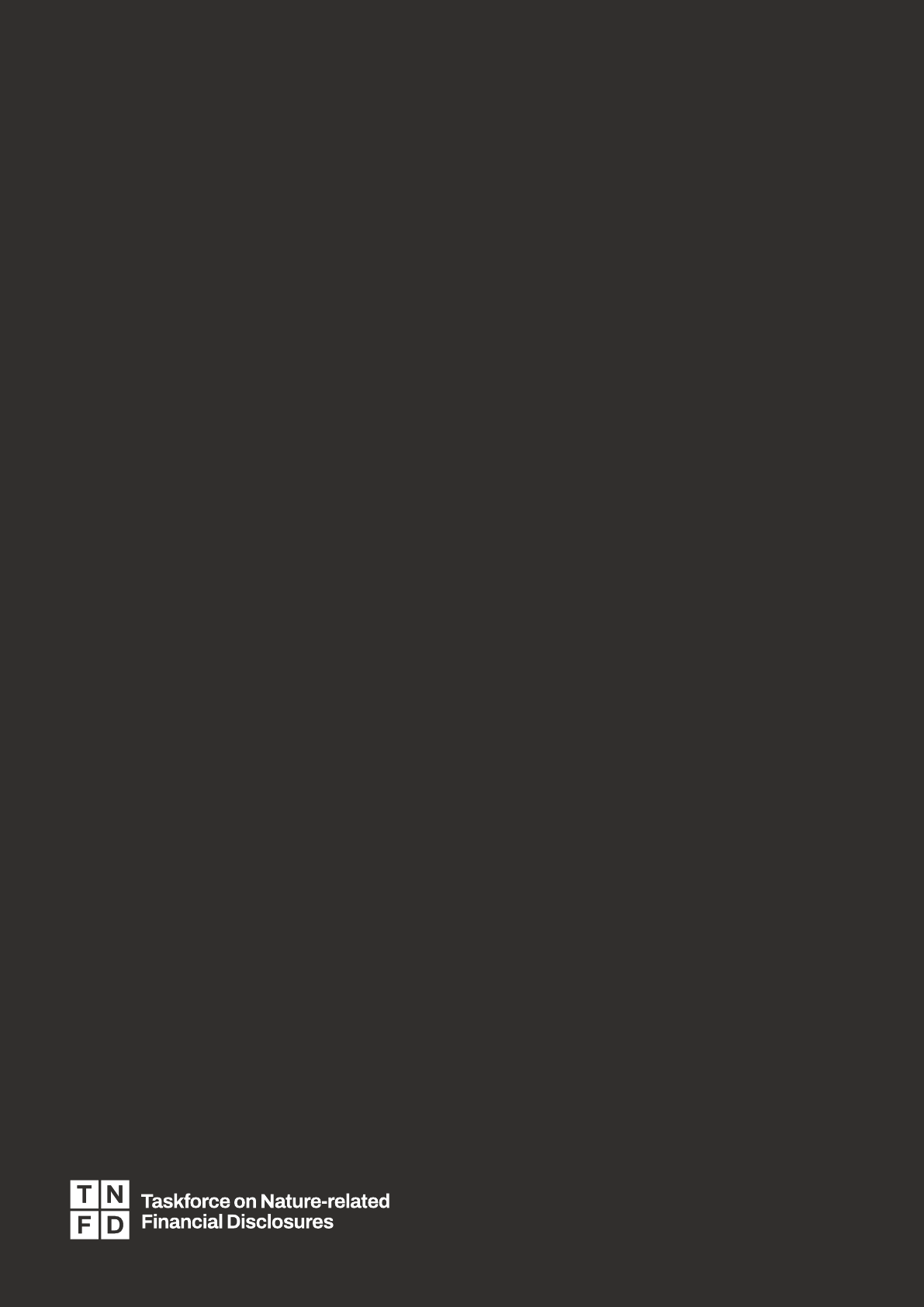
Draft sector metrics
For market consultation and feedback – December 2023
45
tnfd.global
